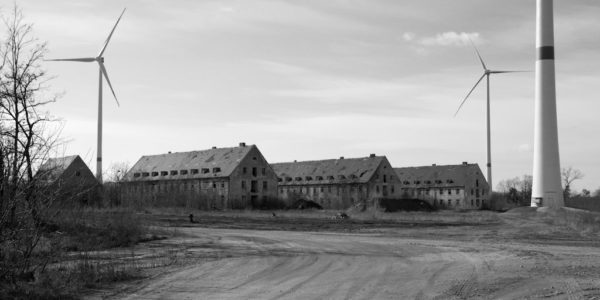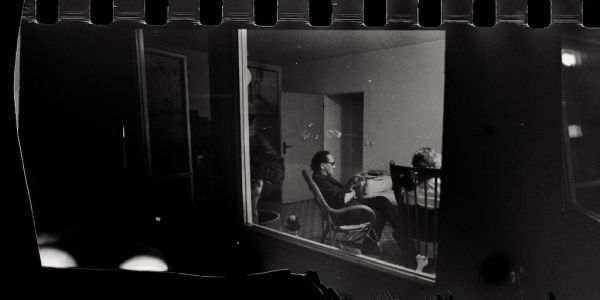TIFF Dispatch: In Conversation With Thomas Heise, Director Of HEIMAT IS A SPACE IN TIME

Monique Vigneault is a Mexican-Canadian film critic. She regularly covers…
Prolific German documentarian Thomas Heise returns with Heimat is a Space in Time, a sweeping documentary that examines Germany’s national history through a rife collection of letters and photographs from Heise’s own ancestry. It barrels through the course of one hundred years, beginning at the first World War and ending at the fall of the GDR.
Through Heimat, Heise constructs a meditational essay gauzed in seductive, bleak black-and-white shots of Germany that asks, and sometimes succeeds at answering the unanswerable questions of his nation’s complex past. Heimat is a Space in Time was initially screened as part of Toronto International Film Festival’s 2019 Wavelength’s programme.
Portions of this interview were conducted in German through translator Naomi Buck and have been edited for clarity.
Monique Vigneault for Film Inquiry: When did the initial idea for Heimat initially strike?
Thomas Heise: It’s hard to say exactly why I started making it. I had the material, I had these letters. And I knew that it was time to do something with it. I just knew that so it’s hard to really say exactly what.
It’s really more so the question that the material evoked, and it was the thoughts going around my mind in an attempt to answer these questions. So really, it was my effort to attempt to answer some questions for myself.
On that note, what was the process of unspooling all of this personal and rich history of your native Germany? Was the process of getting this narrative cathartic in some sense?
Heise: I’ve heard that question before, and I find it really hard to answer, I don’t think it can be answered. I don’t think there is a result that is final. I would say that for the time being, this film has helped me to sort these thoughts. So for now, there’s there’s a sense of order, but it could be that in 10 years, I revisit it and it has a different order.
But it was definitely an existential opportunity for me, this film.

How did you find the balance between the artful and the archeological?
Heise: I’ll open with a quote from Antonioni’s Death in Venice: “Making films is like a hunter in the dark and you don’t need you don’t know if you’ve shot your prey.” Really, a lot of it is just following your own nose and trusting your instincts. It’s a very instinctive process. How you find the balance is really by trusting your instincts and taking risks. I didn’t commit myself to a chronological narrative.
It sounds a little kitschy, but it’s like getting good starting on a journey and you don’t know where it’s going to end.
The film sits at under four hours. Why did you stick with that runtime?
Heise: So the runtime is not what we set out to do necessarily, but it’s what it ended up being for a variety of reasons. Some of them are internal reasons and some of them are external reasons. The external reason would be that the Germany is about to celebrate 30 years post reunification. And so that was an opportunity from the in terms of producing it and finding selling it and having interest in it. So if we hadn’t made this deadline the film would not have, there wouldn’t have been interest in the film.
And then it’s also a question of how much the viewer can take in. So in that sense, four hours is actually not that long. Considering all the other characters and all the other narratives we could have explored.
So it really is a question of how much a how much we could really holistically do in year of shooting, and how much how much the viewer could take in. And also what we’re capable of, but it could have been a six hour film or an eight hour film, you know, given the story and all the possible extensions of it.
On a broader vein, when did you first take an interest in film and documentaries? When did you decide expression through film was something you wanted to do?
Heise: I always knew I wanted to make movies.
I had a super eight as a kid and I and I shot stuff, but I wanted to make feature films. I wasn’t interested in documentaries. I studied to be a printer. But having studied I didn’t actually start working in a in a printing shop. I went straight to Default, which was the The East German government’s only film production unit. And I said I was willing to do anything so they put me on the telephone. I was responsible for answering the phone, and then I met a producer there.
So this producer decided that he should try something else and threw me into the water and I was suddenly responsible for managing an entire crew and a set. And in the film was the story of a young couple who were having marital issues. And the state sensor didn’t think the film wouldn’t approve the film, because they claimed that these kinds of marital issues didn’t exist in East Germany. And so my job was to go out and demonstrate that these problems didn’t exist. That was my first taste of blood, really.

I’m going under the pretense here that that one must be somewhat nostalgic if you are constantly looking into the past on a historical and personal level. What is your relationship with the past and seeking truth through cinema?
Heise: I think there is no truth in the past. It’s not a question of finding the truth. I made another film called Iron Age in 1991. I tried to make it in East Germany but it was was not allowed and was censored until it finally came out in 1991. And there’s a line in that film, that is basically, “The future is the past. And the present is what remains.”
So, take a minute to think about that.
What I’m trying to say with that is that, we’re kidding ourselves if we think that there’s a truth. The theme in really all my films is the idea that while you can imagine history as a linear thing, actually it’s a pile.
This also explains the way I’ve made this movie. It’s an effort to show you know he’s got historic texts on contemporary images to show that the history and the present and the future are really not it’s not a linear thing.
Film Inquiry thanks Brian Geldin PR, and Thomas Heise.
Heimat is a Space in Time opens on March 13th at Anthology Film Archives in New York and Lumiere Cinema at the Music Hall in Los Angeles.
Does content like this matter to you?
Become a Member and support film journalism. Unlock access to all of Film Inquiry`s great articles. Join a community of like-minded readers who are passionate about cinema - get access to our private members Network, give back to independent filmmakers, and more.
Monique Vigneault is a Mexican-Canadian film critic. She regularly covers world cinema on the festival circuit.













